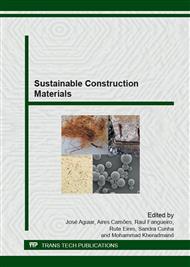p.400
p.410
p.421
p.433
p.447
p.455
p.467
p.473
p.479
Durability of Natural Fibers for Geotechnical Engineering
Abstract:
Fibrous structures based on natural fibers have gained a key space when it is required to perform functions like separation, drainage, filtration, protection and soil reinforcement. The use of natural fibers turns engineering work more sustainable, since they are renewable, biodegradable, energy efficient and non-toxic raw materials. In this work, the influence of degradation caused by UV rays, heat and moisture on the mechanical behavior of vegetal natural fibers used in geotextiles, including sisal, coir and banana fibers, was studied. Natural fibers have been subjected to accelerate aging agents using QUV equipment and to real conditions, in contact with soil over a 3 months period. Samples were removed every 15 days and their mechanical behaviour evaluated under tensile. Moreover, the morphological modifications in the fibers structure have been also analyzed using SEM. The results show a significant degradation over the first 15 days for all types of fibers used. Sisal and banana fibers subjected to degradation in soil, present higher tensile strength loss over time than fibers subjected to accelerate aging tests in QUV. For geotextiles design, important remarks from the results can be obtained including: banana fibers are quite degraded by aging and soil conditions making them difficult to be applied in geotechnical engineering; sisal and coir fibers present high potential to perform various functions in contact with soil.
Info:
Periodical:
Pages:
447-454
Citation:
Online since:
December 2014
Authors:
Keywords:
Price:
Сopyright:
© 2015 Trans Tech Publications Ltd. All Rights Reserved
Share:
Citation:


